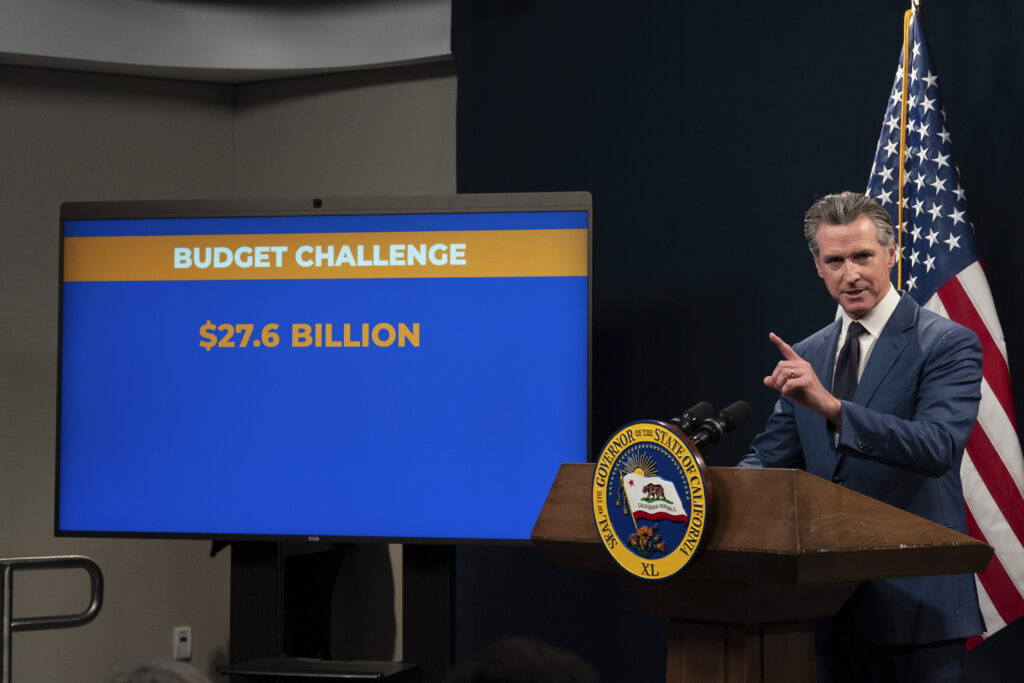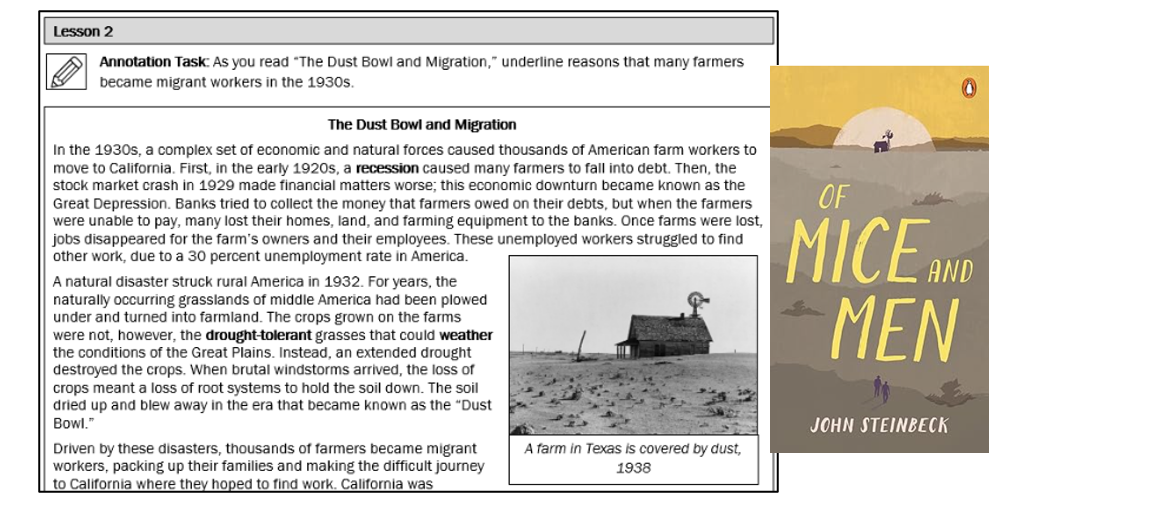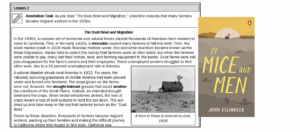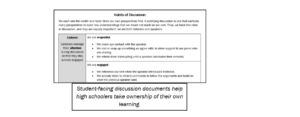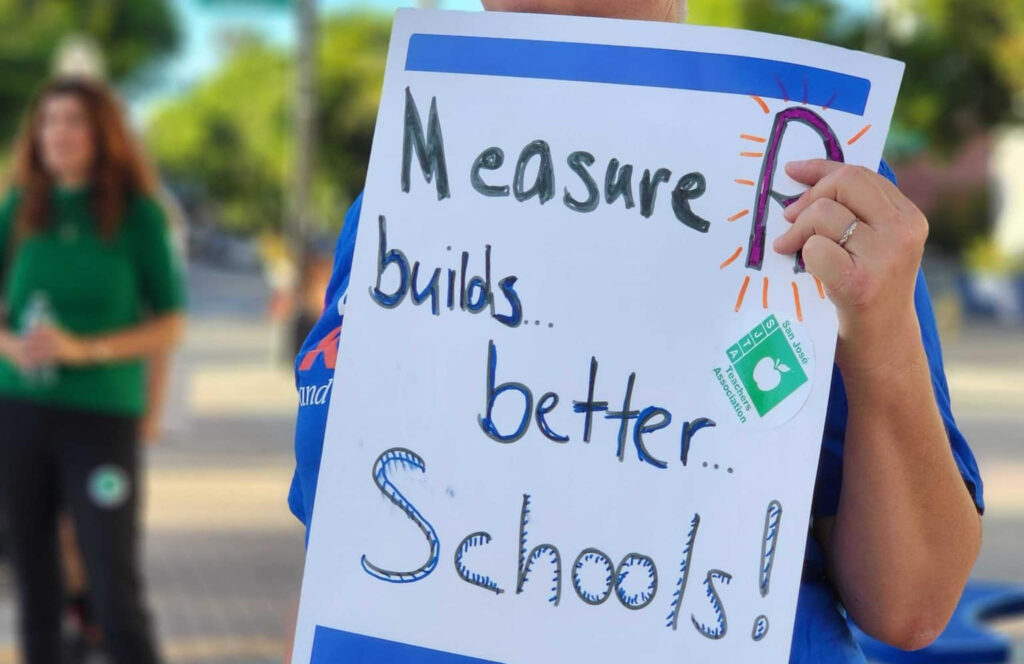
Gov. Gavin Newsom unveils his revised 2024-25 state budget during a news conference in Sacramento on May 10.
Credit: AP Photo/Rich Pedroncelli
The Newsom administration has settled a disagreement with K-12 education groups over multiyear funding that will provide nearly all of the money the groups had demanded, although deferring and delaying several billion dollars for at least a few years.
Pending legislative approval, the compromise that the California Department of Education negotiated with the California Teachers Association (CTA) would remove an obstacle to resolving the 2024-25 state budget by the June 15 deadline.
The deal would preserve Gov. Gavin Newsom’s promise to exempt TK-12 schools and community colleges from appreciable funding cuts that other areas of the state budget would face, including the California State University and the University of California.
The proposal also would meet the legal requirements of Proposition 98, the 4-decade-old formula that calculates the minimum portion of the general fund that must be spent on education. It was Newsom’s plan in his original January budget to spare schools and community colleges immediate cuts while scaling back Proposition 98 growth in future years that led CTA and the California School Boards Association to threaten to take Newsom to court with a lawsuit it had reasonable odds of winning.
“This is a good deal for public schools. In its simplest terms, this agreement will protect the state’s core TK-12 investments, like the Local Control Funding Formula and new whole child programs,” said Derick Lennox, senior director of governmental relations and legal affairs for the California County Superintendents Association, who was briefed on the negotiations Tuesday. “If approved by the Legislature, the governor will be able to honor his commitment to protect school funding amidst a challenging budget.”
Challenging is an understatement. Because the state will fall short of full funding for the current year, 2023-24, the Legislature would suspend Proposition 98 for the first time since the height of the Great Recession in 2010-11 by $5.5 billion. The money owed, an IOU called the “maintenance factor” under Proposition 98 terminology, would be repaid over multiple years, as determined by the growth in state revenue. The repayments would start with $1.3 billion in 2024-25.
The deal would reintroduce funding deferrals — another accounting maneuver from the Great Recession, though at a smaller magnitude. As opposed to a funding suspension, a deferral is a late payment, in which the Legislature shifts funding by days or months from one fiscal year to the next, and districts are on the hook for money they’ve already spent.
The settlement calls for three years of deferrals, ranging from $1.3 billion to $2.6 billion, from 2023-24 through 2025-26. The last deferral, for $2.4 billion, would make up about 2% of funding to community colleges and school districts. Together, the three deferrals should have no appreciable impact on school and community college budgets but will require $2.4 billion in future school funding to pay off. They will involve an accounting shift from June, the last month of one fiscal year, to July, the first month of the next.
“The agreement reached with the governor to protect public school funding is a critical step forward for California’s schools and communities,” said CTA President David Goldberg. “It ensures that students, educators, and families aren’t impacted by cuts to the classroom and includes protection against additional layoffs of educators.”
The revenue conundrum reflects a slow rebound from an unexpected drop in state revenue following the Covid pandemic. Because of winter storms in early 2023, the federal government and California pushed back the filing date for taxes by six months. Without accurate revenue estimates when they set the 2023-24 budget in June, Newsom and the Legislature appropriated $8.8 billion more than the Proposition 98 minimum.
Since TK-12 and community colleges had already budgeted and spent the money, Newsom promised to hold them harmless. But in his first budget draft in January and his May revision, Newsom proposed to treat the $8.8 billion as an off-the-books, one-time overpayment; CTA and school groups viewed it as an ongoing obligation, that, as spelled out by voters in approving Proposition 98, would become the base for the following year’s minimum level of the guarantee.
“They arrived at a solution that gives the Governor and Legislature near-term budget flexibility while abiding by the state’s constitutional provisions related to minimum funding for schools,” education consultant Kevin Gordon said. “A negotiated suspension of Prop 98 has been the obvious solution since the outset of the debate.”
Here’s how the negotiated deal resolves the dispute over the three-year period covered by the budget:
2022-23
Original Proposal: Newsom proposed an unorthodox move: holding the general fund, not Proposition 98, responsible for paying for the $8.8 billion shortfall over five years, starting in 2025-26, at $1.8 billion per year.
Compromise: Shift an unallocated $2.6 billion in one-time funding from 2022-23 into 2023-24. That would lower the ongoing Proposition 98 increase from $8.8 billion to $6.2 billion. The effect would be to cut general fund repayments by $500 million to $1.3 billion per year for five years. And it would lower the calculation for the following year’s Proposition 98 minimum.
2023-24
The state would drain $8.4 billion from the Proposition 98 reserve fund, built up during a half-decade of good revenue years, to pay off a continuing Proposition 98 shortfall, including the $2.6 billion deferral from 2022-23.
Compromise: The $6.2 billion rise in the Proposition 98 base in 2022-23 would raise the Proposition 98 minimum by $4.2 billion. Lacking the money to pay for it, the Legislature, by an anticipated two-thirds majority, would suspend the Proposition 98 base by $5.5 billion; this would include $1.3 billion, the first installment of the maintenance factor, due to be repaid in 2024-25. As a result of the $5.5 billion suspension, the Proposition 98 base would be lowered to $101.3 billion.
2024-25
The level of Proposition 98 is determined by several factors, called “tests,” that are tied to changing economic conditions, such as a rise in state spending or personal income, and the increase in the base from the year before. The 2024-25 Proposition 98 level, under Test 1, would be set at about 39% of the general fund: an estimated $110.6 billion. This would include a $1.3 billion maintenance factor repayment.
The Department of Finance says that “overall, the Agreement provides stability for schools both in the short and long-term.”
That’s true as long as the governor’s revenue projections for the next two years hold. But if they come up short, expect additional deferrals or cuts without a state rainy day fund to cushion the impact; many districts were already required to reduce their local rainy day funds this year. And heading into 2025-26, the state will still owe districts and community colleges a $4.5 billion maintenance factor, an IOU with no immediate deadline for repaying it.
“We’re encouraged that the administration has found a way to address the constitutional concerns, and this might be the best funding package that schools could hope for in this budget environment,” said Rob Manwaring, a senior adviser for the nonprofit Children Now. “At the same time, it is difficult to support suspending the constitutional funding guarantee when California schools are still in the bottom five states in terms of student-teacher ratios and other staffing supports.”
